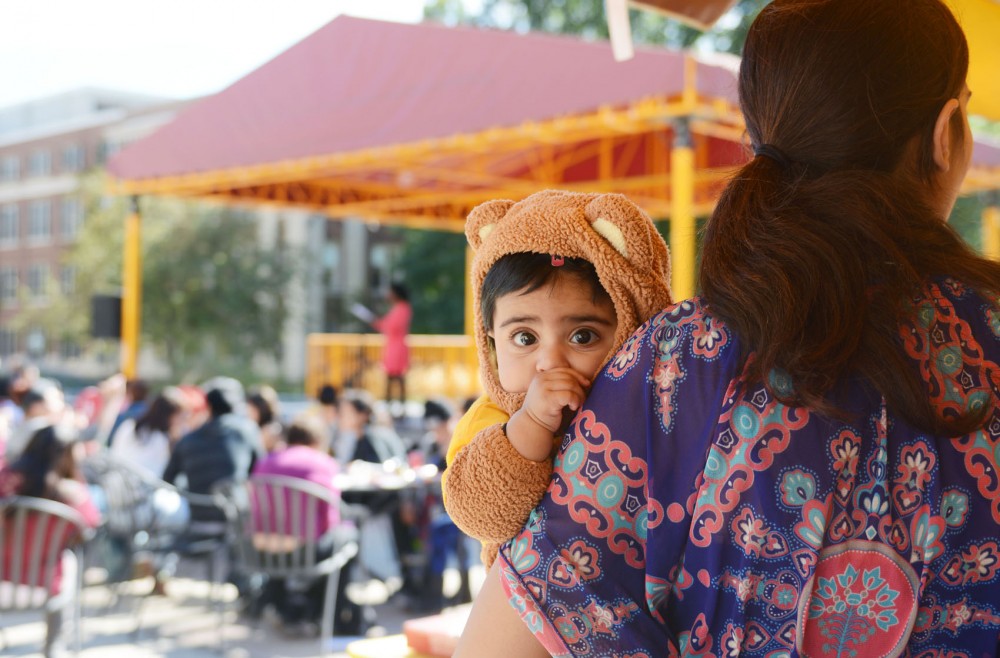It’s Chantel Folden’s first semester at the University of Minnesota. After two years at Inver Hills Community College, she applied to the University on a whim and decided to pursue a bachelor’s degree in communication studies when she was accepted.
Though she may seem to be a typical transfer student, Folden said she has to balance “school time” and “mommy time” with her 2-year-old daughter, Ahlyvia, in addition to academic work.
Folden is one of many University undergraduates who balance coursework with parenting. Some of these student-parents struggle with inclusiveness on campus and understanding from professors, but the University is increasing efforts to address those problems.
Susan Warfield, director of the University’s Student Parent HELP Center, said some student-parents don’t feel connected to the University in the way that other students do.
“Most of the higher ed research strongly shows that connection to campus is a good indicator of college success,” she said. “[Student-parents] are not going to be able to find a community as easily as an 18-year-old living in a dorm.”
Folden said finding a community of people at the HELP Center with experiences similar to her own made her feel more included on campus.
It’s difficult to measure how many student-parents are on campus, but Warfield said 300 to 400 University students claim dependents on their financial aid forms each year. She said she expects that number to increase as four-year college degrees become more valuable.
Student-parent resources were mandated in 1972 by Title IX, which required that pregnant and parenting students have the same access to school programs as their peers.
In 1967, the University became one of the first in the country to implement a program for student-parents. Today, programs like the HELP center are becoming more popular nationwide.
“In the last two years especially, there was money tied to the [Affordable Care Act] to fund college access programming for teen parents and single women under 25,” Warfield said.
In June, the U.S. Department of Education issued a letter drawing attention to these programs and asking both high schools and colleges to do more to help student-parents.
“[The letter] came out with suggestions of what schools should do to make a more friendly environment for students attending both college and high school,” Warfield said. “For the first time they said … that they’re going to expect post-secondary [education] to focus on their students with children as well.”
The HELP center held its 10th annual Student Parent Visibility Day on Wednesday to increase awareness of undergraduate student-parents.
Amelious Whyte, Office of Student Affairs assistant dean, said the University has also attempted to address student-parents’ issues with inclusiveness by inviting them to participate in events such as the homecoming parade and a faculty and staff event at University President Eric Kaler’s home.
In May 2010, the University’s absence policy changed to include the “illness of the student or his or her dependent” as an absence for which instructors should make reasonable accommodations.
Despite this change, some student-parents say their professors don’t make it easier to balance school and parenting.
Jared Erickson, a University senior studying biochemistry and microbiology, is the father of a 3-year-old and an 8-month-old. Though working with classmates on group assignments contributes to his academic stress, he said, his biggest issue comes from instructors.
“Everybody’s busy with classes,” Erickson said. “It’d be easier if the instructors were more understanding.”
Warfield said many professors and advisers aren’t always supportive of student-parents and don’t often know about resources like the HELP Center, which is why it holds events like Wednesday’s Visibility Day.
Melissa Winship, a counselor at South Education Center Alternative Learning Center, a high school with a program for pregnant students and student-parents, said she wants her students to know that it’s possible to go to school while being a parent.
“The amount of work that they’re going to have to do while parenting at the same time … that’s very scary to them,” she said.
Though the University could do a better job of increasing awareness of student-parents, Whyte said, the institution’s main focus is helping those parents in need.
“Do you spend a lot of your time on outreach, or do you spend most of your time focusing on the students you’re trying to serve?” he said. “And [University programs] spend most of their time focusing on students they’re trying to serve.”











